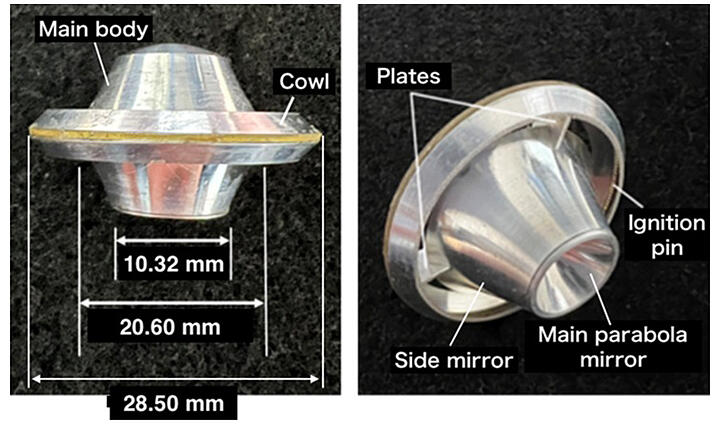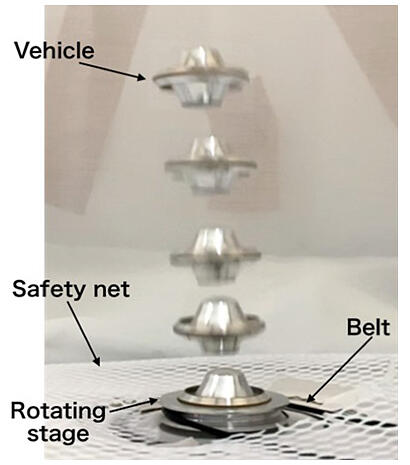Rocket launches typically involve using large amounts of solid or liquid fuel for propulsion. However, laser-propelled rockets that can fly without fuel by repeatedly irradiating the rocket with pulses of laser light are under development. Associate Professor Masayuki Takahashi and Graduate Student (at the time of the research) Yuya Hayadate from Tohoku University's Graduate School of Engineering, Professor Koichi Mori from Osaka Metropolitan University's Graduate School of Engineering, and Associate Professor Akihiro Hayakawa from Tohoku University's Institute of Fluid Science successfully conducted a launch experiment with their uniquely developed multi-parabola laser propulsion vehicle. By repeatedly irradiating pulse lasers, they achieved free flight up to a height of 110 millimeters—approximately seven times the rocket's total length of about 15 millimeters. Moreover, to help realize stable flight, they developed a laser tracking system that can detect the rocket's movement in real-time and adjust the laser irradiation position, demonstrating a world-first capability to provide continuous thrust. This represents a significant step toward realizing rocket launches using laser propulsion systems and was published in Scientific Reports.

Provided by Tohoku University
In laser propulsion, where lasers are irradiated from a ground-based station to launch a rocket without fuel, a parabolic mirror (a curved mirror where light converges in one spot) is attached to the rocket. When the laser light is focused, the air near the focal point ionizes and transforms into plasma. This plasma absorbs further laser energy and heats up, rapidly transferring heat to the surrounding air, generating a shock wave that pushes the rocket's body and creates thrust.
One estimate suggests that even considering the initial laser oscillation base construction costs, launch expenses could be reduced to approximately one-fourth of conventional rocket launches. If laser propulsion launch technology is established, space travel might become more accessible.
However, several challenges remain for practical implementation. One significant issue is the rocket's tendency to deviate from the laser axis, making stable flight difficult to maintain. The research group had previously conducted primarily numerical simulations. For this study, they performed launch experiments to verify passive control performance—where the rocket naturally returns to the center when deviating from the laser axis—and developed an active control system that follows the rocket's movement and alters the laser irradiation position, as well as demonstration tests.
For passive control, they ingeniously designed the rocket's body. They attached a spike-nozzle shaped mirror to the main body, designing it so that lasers irradiated on the body would be focused in a circular area around the main body. They also installed a ring-shaped component (cowl) covering this circular focusing area. With this structure, when the rocket deviates sideways from the laser irradiation axis during flight, the laser becomes unevenly focused inside the cowl.
As a result, the shock wave generated by laser heating becomes uneven, and the force of the shock wave pushing against the cowl also becomes asymmetric. Through the action of these non-symmetric forces, the rocket naturally moves in a direction that draws it back to its original central axis (laser axis), automatically correcting its approach without requiring active control.
Furthermore, the group positioned a parabolic mirror along the rocket's axis. When the rocket's axis tilts from the laser irradiation axis, the laser focusing position within the parabolic mirror changes, correspondingly altering the shock wave shape to counteract the angle deviation.
Due to the combination of spike-nozzle shaped and parabolic mirrors, this rocket is called a "multi-parabola laser propulsion vehicle."

Provided by Tohoku University
To verify the passive control capabilities, the group conducted a free flight launch experiment in the laboratory, repeatedly irradiating laser pulses vertically upward at the rocket. Using approximately 5-joule lasers with a repetition frequency of 50 Hz, they succeeded in free flight of an approximately 2-gram rocket to a height of 110 millimeters, about seven times the rocket's total length of 15 millimeters. The rocket was observed to naturally move back toward the laser irradiation axis, experimentally demonstrating passive control. The flight looked almost like a UFO gently rising.
However, passive control alone suggested insufficient reliability for stable flight lasting up to tens of minutes. Therefore, as a mechanism for active control, the group also developed a laser tracking system that can track the rocket's movement in real-time and adjust the laser irradiation accordingly.
To quantitatively evaluate the tracking system's performance, they mounted the propulsion vehicle on a custom robot arm and moved it at speeds similar to free flight, rather than using laser-based free flight. Using a stereo camera, they captured the device's position and velocity in space in real-time. This information was sent to a laser scanning system composed of motors, belt-type actuators, and mirrors to control laser irradiation position in accordance with the device's movement. They successfully demonstrated, for the first time in the world, that they could track the laser with sufficient accuracy and continuously generate shock waves and thrust at rocket movement speeds anticipated during free flight.
In this experiment, the longest flight lasted approximately 0.26 seconds. Moving forward, the group plans to conduct launch tests using the laser tracking system to verify whether stable beam-riding flight can be achieved throughout the entire launch process. The research team ultimately aims to use higher-power repetitive pulse lasers to reach space over 100 kilometers up.
Journal Information
Publication: Scientific Reports
Title: Free-flight and tracking experiments of a multi-parabola laser propulsion vehicle
DOI: 10.1038/s41598-025-00429-0
This article has been translated by JST with permission from The Science News Ltd. (https://sci-news.co.jp/). Unauthorized reproduction of the article and photographs is prohibited.




